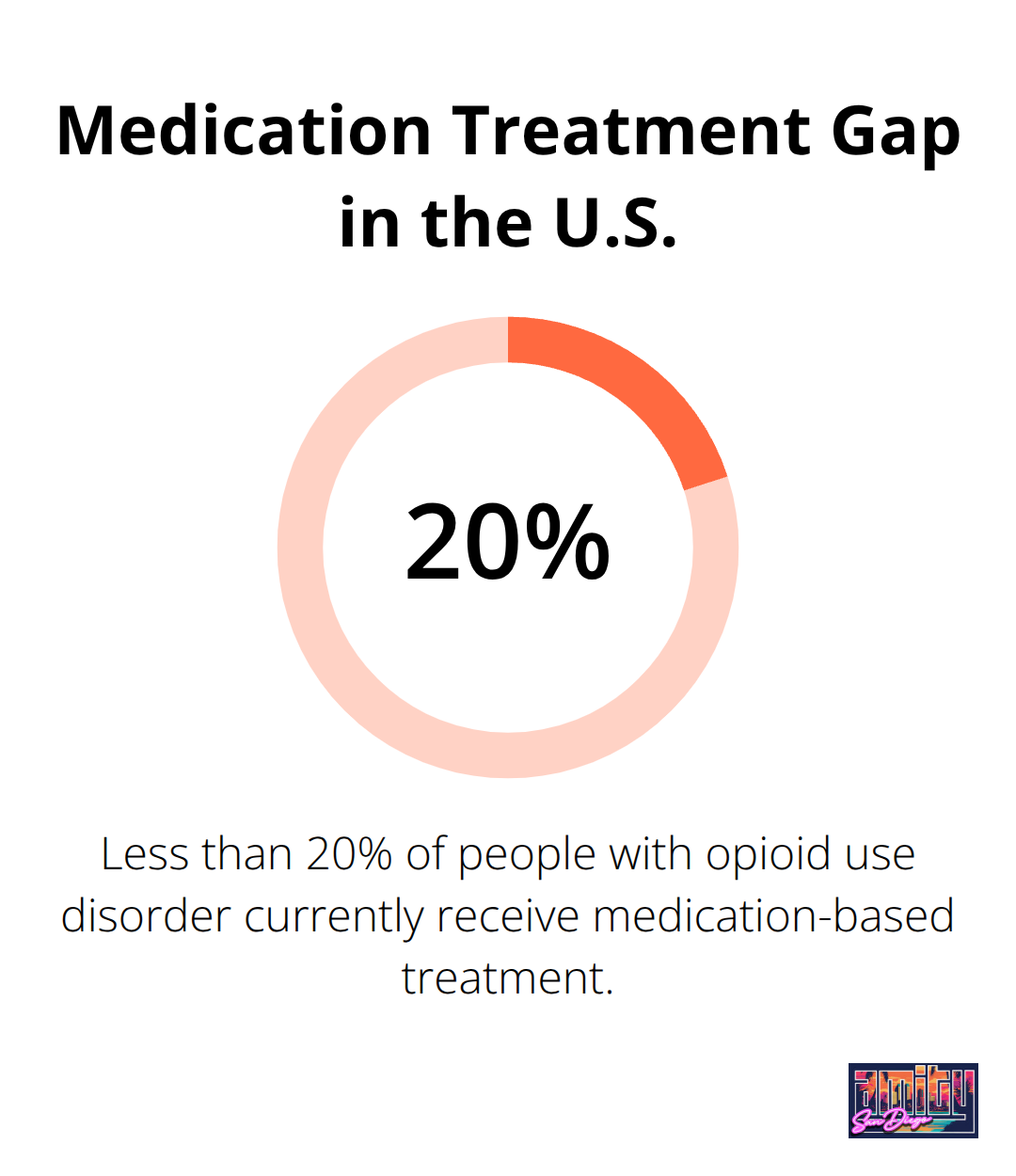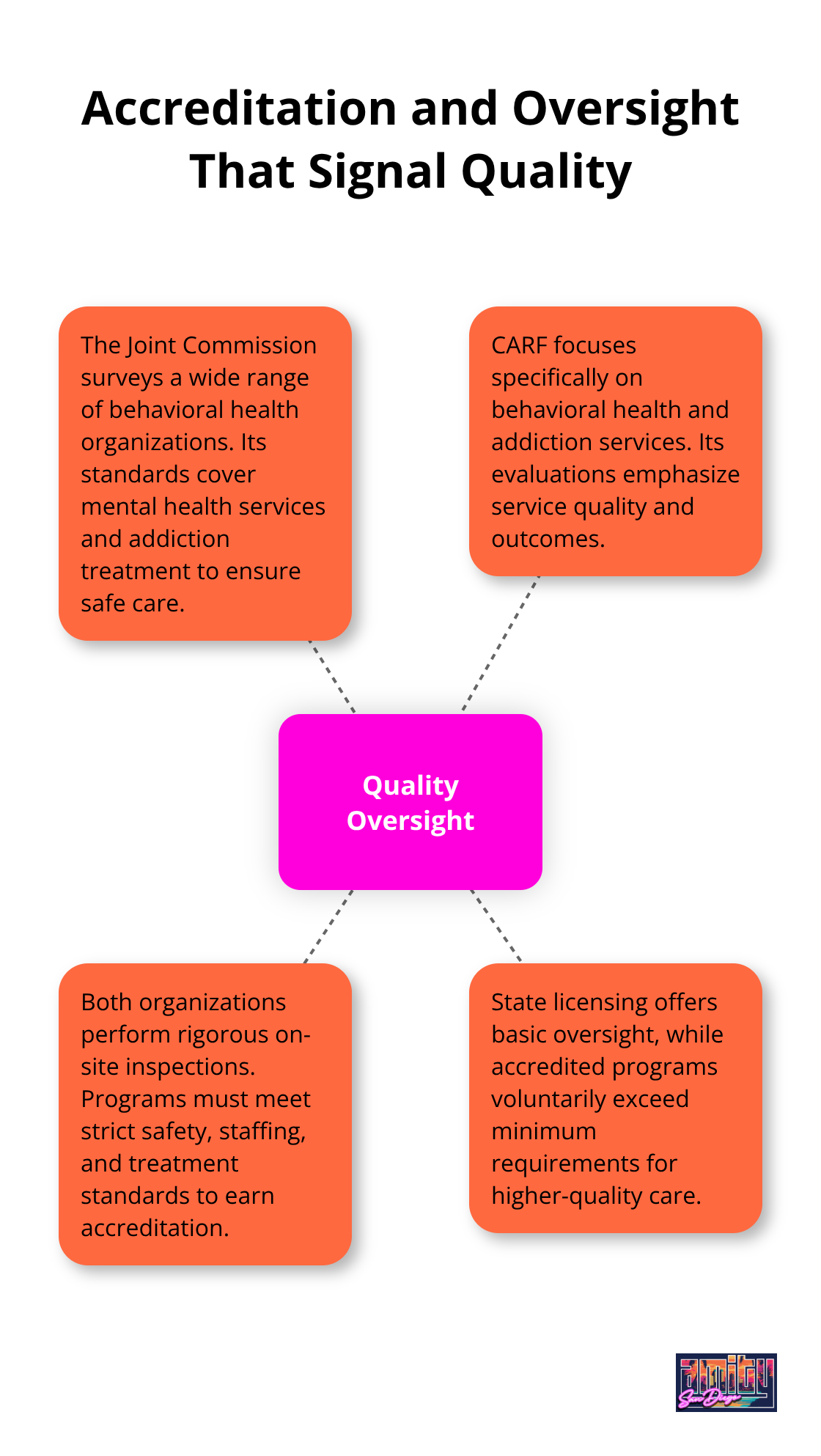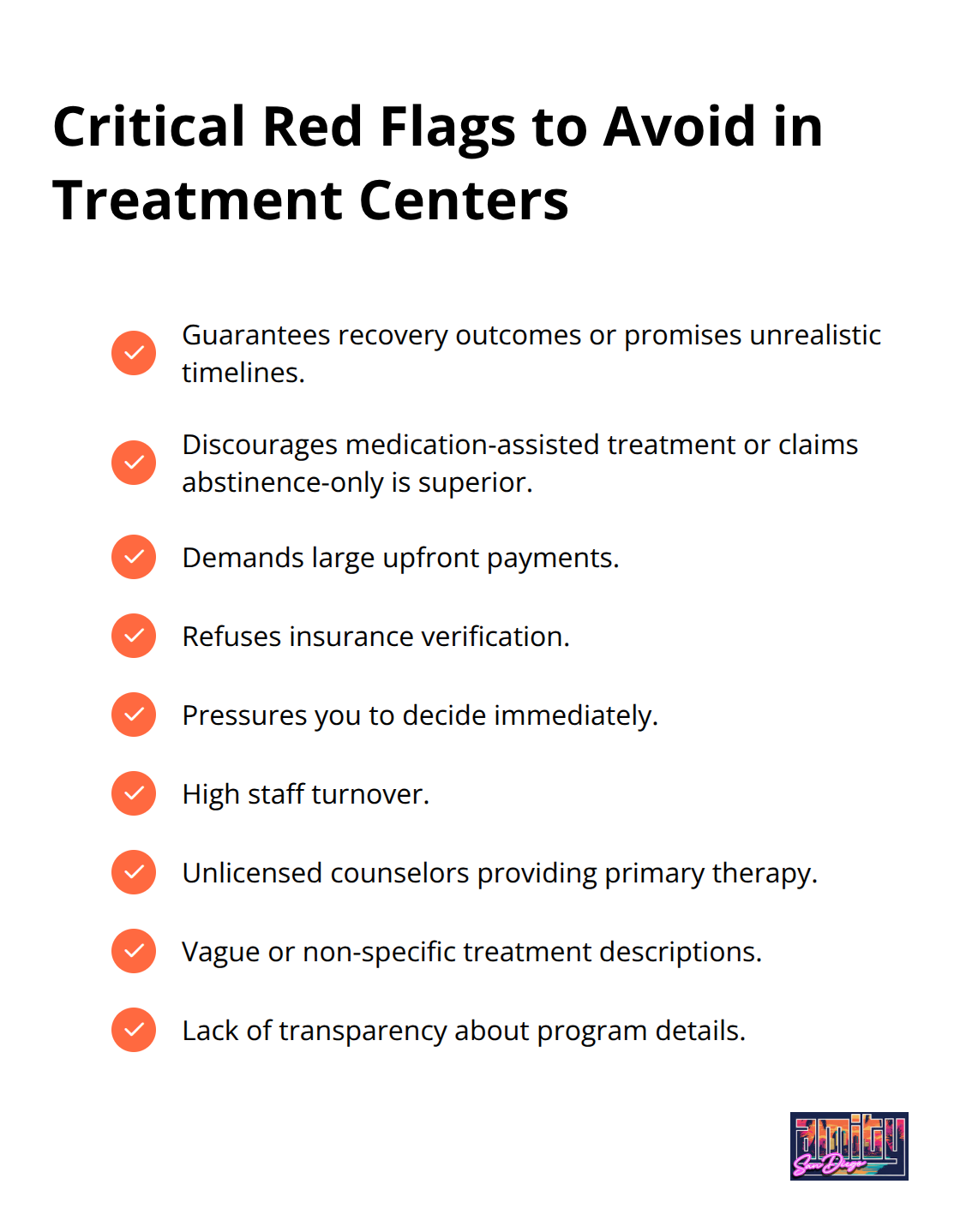Finding the right opioid addiction treatment programs can feel overwhelming when you’re facing this challenge. The sheer number of options and treatment approaches makes the decision even harder.
We at Amity San Diego understand that choosing effective treatment requires knowing what to look for and which questions to ask. This guide breaks down the essential steps to help you find quality care that matches your specific needs.
What Treatment Program Types Should You Consider
Opioid addiction treatment comes in three main formats, and your choice directly impacts your recovery success. Inpatient programs require 24/7 residential stays that last 30-90 days and provide intensive medical supervision with structured therapy schedules. These programs work best for severe addictions, multiple failed treatment attempts, or medical complications that require constant monitoring.
Outpatient programs allow you to maintain work and family responsibilities while you attend treatment sessions 3-5 times weekly. The Substance Abuse and Mental Health Services Administration reports that outpatient programs show comparable success rates to inpatient care when patients have stable housing and strong support systems.
Medication-Assisted Treatment Changes Recovery Outcomes
Medication-Assisted Treatment combines FDA-approved medications with counseling to treat opioid addiction effectively. Methadone, buprenorphine, and naltrexone reduce cravings and withdrawal symptoms while they block euphoric effects of opioids. Research shows that these medications can reduce opioid use and other negative health outcomes significantly.
Less than 20% of people with opioid use disorder currently receive medication-based treatment, despite these proven outcomes. Quality programs offer multiple medication options and adjust doses based on individual response patterns (rather than one-size-fits-all approaches).

Dual Diagnosis Programs Address Root Causes
Co-occurring mental health disorders affect many people with opioid addiction according to SAMHSA data. Depression, anxiety, PTSD, and bipolar disorder often drive initial opioid use and complicate recovery efforts significantly. Standard addiction programs that ignore mental health issues show much higher relapse rates.
Integrated dual diagnosis programs treat both conditions simultaneously with specialized therapists who have training in both addiction and mental health. These programs require separate licensing and staff qualifications beyond basic addiction counseling (which many facilities lack). Look for programs that employ licensed clinical social workers, psychiatrists, and dual-diagnosis certified counselors on their treatment teams.
Intensive Outpatient Programs Offer Flexibility
Intensive Outpatient Programs (IOP) bridge the gap between inpatient care and standard outpatient treatment. These programs typically require 9-12 hours of treatment per week across multiple days while you maintain your daily responsibilities. PHP (Partial Hospitalization Programs) provide even more intensive support with 20-25 hours weekly but still allow you to return home each evening.
Both options work well for people who need structured support but have stable living situations and strong family support systems. The flexibility helps you practice recovery skills in real-world situations while you still receive professional guidance.
When you understand these program types, you can better evaluate which treatment centers offer the specific services you need and how their staff qualifications match your treatment requirements. For comprehensive addiction treatment San Diego residents can access quality care options.
What Should You Prioritize When Selecting Treatment
Accreditation separates legitimate treatment centers from substandard facilities that waste your time and money. The Joint Commission surveys many types of organizations under behavioral health care standards, including mental health services and addiction treatment. CARF focuses specifically on behavioral health and addiction services. Both organizations conduct rigorous on-site inspections and require programs to meet strict safety, staffing, and treatment standards.

State licensing provides basic oversight, but accredited facilities voluntarily exceed minimum requirements. Facilities without proper accreditation often lack qualified staff, use outdated treatment methods, or operate with insufficient medical oversight.
Staff Credentials Determine Treatment Quality
Licensed clinical staff make the difference between effective treatment and expensive failure. Look for programs that employ board-certified addiction medicine physicians, licensed clinical social workers, and certified addiction counselors with advanced training.
Quality staffing ratios contribute to better patient access and outcomes in treatment programs. Many facilities hire undertrained technicians or rely heavily on peer counselors without proper clinical supervision.
Quality programs maintain at least 60% of their staff with master’s degrees or higher and require ongoing education. Ask potential facilities for their treatment protocols and staff credentials before you make any decisions, as dual diagnosis treatment requires psychiatric expertise that general counselors cannot provide.
Insurance Coverage Affects Long-Term Success
Insurance verification determines your actual treatment costs and coverage duration limits. Most major insurance plans cover addiction treatment under the Mental Health Parity Act, which prohibits separate financial requirements and treatment limitations that apply only to mental health and substance use disorder benefits.
Aetna, Blue Cross Blue Shield, and Cigna typically cover intensive treatment, while Medicare covers outpatient sessions when medically necessary. Quality facilities employ dedicated insurance specialists who verify benefits before admission and handle prior authorizations efficiently.
Programs that demand large upfront payments or refuse insurance often provide substandard care. Private pay options should include transparent pricing and payment plans (not hidden fees or surprise charges after treatment begins).
Treatment Approaches Shape Recovery Success
Evidence-based treatment methods produce measurably better outcomes than programs that rely on outdated approaches or unproven techniques. Look for facilities that use Cognitive Behavioral Therapy, Dialectical Behavior Therapy, and trauma-informed care as core treatment components.
Programs should offer both individual and group therapy sessions with licensed therapists who specialize in addiction treatment. Ask about their specific approach to addiction treatment and how they tailor programs to individual needs, as the most effective facilities integrate multiple therapeutic approaches rather than relying on a single treatment method.
For comprehensive addiction treatment San Diego options, understanding these selection criteria helps you research and evaluate specific treatment centers in your area.
How Do You Research Treatment Centers Effectively
Effective research starts with targeted questions during initial consultations that reveal program quality and treatment approaches. Ask facilities about their average length of stay, typical daily schedule, staff-to-patient ratios, and specific medications they prescribe for opioid use disorder. Quality programs provide detailed answers and offer facility tours without hesitation.
Request information about their success rates, relapse prevention strategies, and aftercare support services. Programs with comprehensive aftercare show better long-term outcomes than facilities that discharge patients without ongoing support.
Critical Warning Signs That Signal Poor Treatment
Several red flags immediately disqualify treatment centers from consideration. Facilities that guarantee recovery outcomes or promise unrealistic timelines operate outside medical standards and likely use predatory marketing tactics. Programs that discourage medication-assisted treatment or claim abstinence-only approaches are superior contradict established medical guidelines from SAMHSA and the American Society of Addiction Medicine.

Avoid facilities that demand large upfront payments, refuse insurance verification, or pressure you to decide immediately without time for research. Centers with high staff turnover, unlicensed counselors providing primary therapy, or vague treatment descriptions typically provide substandard care that wastes time and money.
Success Rates and Reviews Require Careful Analysis
Treatment center success rates vary widely based on measurement methods and follow-up periods (making direct comparisons difficult). Programs that track patients for 12 months post-treatment provide more reliable data than facilities that measure success at discharge only. The Substance Abuse and Mental Health Services Administration reports that facilities using standardized outcome measures show transparency that correlates with better patient results.
Online reviews reveal important patterns about staff responsiveness, facility conditions, and treatment effectiveness, but focus on specific details rather than emotional testimonials. Look for reviews that mention concrete aspects like medication management, therapy quality, and insurance processing efficiency rather than general satisfaction ratings.
Questions That Reveal Program Quality
Ask potential treatment centers about their medical director’s credentials and board certifications in addiction medicine. Quality programs employ physicians who specialize in addiction treatment (not general practitioners who treat addiction as a side practice). Inquire about their approach to withdrawal management, medication protocols, and how they handle medical emergencies during treatment.
Request details about their therapy staff qualifications and treatment methodologies. Programs should explain their specific therapeutic approaches, group therapy formats, and individual counseling frequency. Ask how they customize treatment plans and what happens if your initial treatment approach needs adjustment.
Verification Steps That Protect Your Investment
Contact your insurance provider directly to verify coverage details and confirm the facility’s network status. Insurance representatives can explain your specific benefits, copayment requirements, and any prior authorization needs. This step prevents surprise bills and coverage denials after treatment begins.
Check state licensing boards and accreditation organizations to verify facility credentials and review any disciplinary actions or complaints. The Joint Commission and CARF maintain public databases that show accreditation status and survey results. State health departments often publish inspection reports and violation records for licensed facilities.
For those seeking comprehensive care, consider exploring addiction treatment San Diego options that combine evidence-based approaches with personalized support systems.
Final Thoughts
Effective opioid addiction treatment programs require systematic research and careful evaluation of key factors. Start with accredited facilities that employ licensed clinical staff and offer evidence-based approaches that include medication-assisted treatment. Verify insurance coverage and ask detailed questions about success rates, treatment protocols, and aftercare support during initial consultations.
Time matters when you address opioid addiction. The longer you wait, the more complex treatment becomes and the higher the risk of overdose or other serious complications. Quick action gives you the best chance for successful recovery and prevents further damage to your health, relationships, and career.
We at Amity San Diego provide comprehensive outpatient treatment with personalized care plans that address both addiction and co-occurring mental health conditions. Our licensed therapists offer evidence-based treatment in a supportive environment (designed for recovery success). Contact us today for a free confidential assessment to begin your recovery journey with addiction treatment San Diego options.

